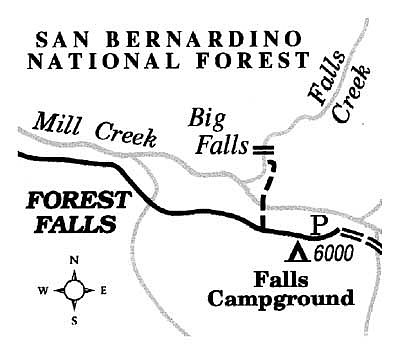 Facebook
Facebook
 X
X
 Instagram
Instagram
 TikTok
TikTok
 Youtube
Youtube
The day begins bright and clear. The springtime sun vaults into the sky over drifts of freshly fallen snow on San Bernardino Mountain's sunny south side and begins to melt them. Gravity pulls the tiny drips of water across and down through the white, crystalline mazes of ice. Many drips combine into narrow rivulets on the mountain's flank. Small trickles join forces, and the sum of their flows combines again into a silvery stream rushing headlong toward the south. Gathering strength, the waters of the stream -- Falls Creek -- rush through a narrow chasm, pitch forward, and transform themselves into a feathery veil of water racing willy nilly over a series of precipices known as Big Falls.
Whether Big Falls is the highest waterfall in all of Southern California is subject to argument, though it is quite fair to call it the tallest of easily accessible cascades. Barely 15 minutes' walk from a paved parking lot gets you to a viewpoint just below the base of the falls. After this season's less-than-normal rainfall, the falls won't exactly be thundering, but they may be impressive nonetheless, at least for the next few weeks.
The trailhead lies near the east end (dead end) of Valley of the Falls Boulevard (a.k.a. Forest Home Road), just east of the cabin community of Forest Falls. Valley of the Falls Boulevard intersects State Highway 38 at a point 6.2 miles east of the San Bernardino National Forest's Mill Creek Station and 14 miles east of Redlands. Note that all vehicles parked at the trailhead must have a National Forest Adventure Pass ($5 per day, or $30 yearly) posted on them. The passes are widely available at ranger stations and general stores along the driving route in.
On the trail you immediately head north across the wide, boulder-tossed bed of Mill Creek. Make your way across this slight obstacle course and reach the far side. There you swing left and begin a steep but short climb up the east slope of Falls Canyon leading to an overlook about 200 yards below the cascading water. Stay on the trail. Do not attempt to climb the falls; several people have been killed or injured trying to do just that.


The day begins bright and clear. The springtime sun vaults into the sky over drifts of freshly fallen snow on San Bernardino Mountain's sunny south side and begins to melt them. Gravity pulls the tiny drips of water across and down through the white, crystalline mazes of ice. Many drips combine into narrow rivulets on the mountain's flank. Small trickles join forces, and the sum of their flows combines again into a silvery stream rushing headlong toward the south. Gathering strength, the waters of the stream -- Falls Creek -- rush through a narrow chasm, pitch forward, and transform themselves into a feathery veil of water racing willy nilly over a series of precipices known as Big Falls.
Whether Big Falls is the highest waterfall in all of Southern California is subject to argument, though it is quite fair to call it the tallest of easily accessible cascades. Barely 15 minutes' walk from a paved parking lot gets you to a viewpoint just below the base of the falls. After this season's less-than-normal rainfall, the falls won't exactly be thundering, but they may be impressive nonetheless, at least for the next few weeks.
The trailhead lies near the east end (dead end) of Valley of the Falls Boulevard (a.k.a. Forest Home Road), just east of the cabin community of Forest Falls. Valley of the Falls Boulevard intersects State Highway 38 at a point 6.2 miles east of the San Bernardino National Forest's Mill Creek Station and 14 miles east of Redlands. Note that all vehicles parked at the trailhead must have a National Forest Adventure Pass ($5 per day, or $30 yearly) posted on them. The passes are widely available at ranger stations and general stores along the driving route in.
On the trail you immediately head north across the wide, boulder-tossed bed of Mill Creek. Make your way across this slight obstacle course and reach the far side. There you swing left and begin a steep but short climb up the east slope of Falls Canyon leading to an overlook about 200 yards below the cascading water. Stay on the trail. Do not attempt to climb the falls; several people have been killed or injured trying to do just that.
